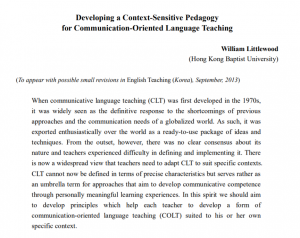
Context-Sensitive Pedagogy – When communicative language teaching (CLT) was first developed in the 1970s. It was widely seen as the definitive response to the shortcomings of previous approaches and the communication needs of a globalized world. As such, it was exported enthusiastically over the world as a ready-to-use package of ideas and techniques.
After reading “Developing a Context-Sensitive Pedagogy for Communication-Oriented Language Teaching”, you can check important issues for ESL teachers on the section PDFs, and visit my channel on YouTube.
From the outset, however, there was no clear consensus about its nature and teachers experienced difficulty in defining and implementing it. There is now a widespread view that teachers need to adapt CLT to suit specific contexts. CLT cannot now be defined in terms of precise characteristics. But serves rather as an umbrella term for approaches that aim to develop communicative competence through personally meaningful learning experiences. In this spirit we should aim to develop principles which help each teacher to develop a form of communication-oriented language teaching (COLT) suited to his or her own specific context.
Introduction to Context-Sensitive Pedagogy
For some 40 years now, discussions of foreign language teaching have been dominated by the concept of ‘communication’. And its various derivatives such as ‘communicative language teaching’ (CLT) and ‘communicative competence’. Hunter and Smith (2012) analyzed the keywords in articles published in one leading UK-based journal (ELT Journal). It showed how communicative ideas and terminology gradually climbed to a dominant status in ELT professional discourse in the years up to 1986.
Since 1986 this trend has continued. Even if much discussion now refers to ‘task-based language teaching’ (TBLT) rather than CLT. This is not so much a shift of direction as a continuation within the same direction. As many writers have noted (e.g. Nunan, 2004, p. 10; Richards, 2005, p. 29). TBLT is best understood not as a new departure but as a development within CLT. In which communicative tasks ‘serve not only as major components of the methodology. But also as units around which a course may be organized (Littlewood, 2004, p. 324).
